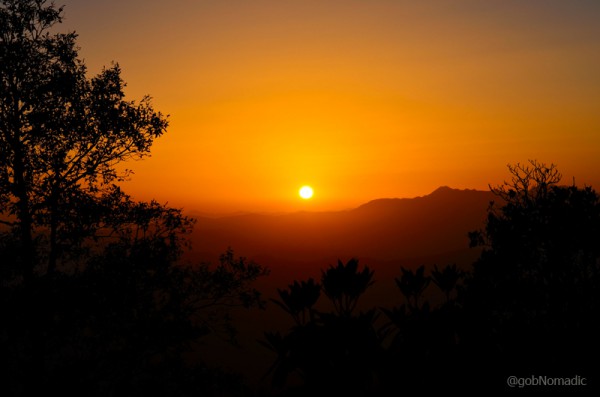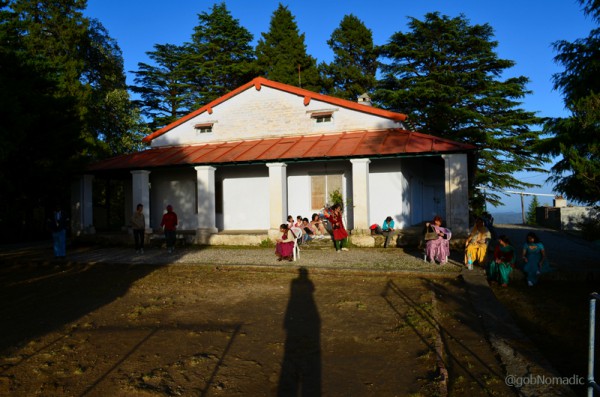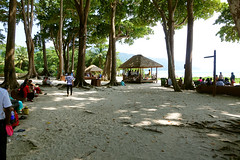
Trishul and Mrigthuni from the Binsar Wildlife Sanctuary. More pics at Flickr Photoset
As I begin to pour my thoughts down concerning a brief holiday-stopover at the notable forests of Jhandidhar, I am nearly getting a feeling that I might be doing injustice to the beauty and inimitability associated with this location. As a travel blogger, I have always felt that writing about experiences after the visits have long been concluded is a grave error one would commit and only the portrayal churned out by the relative thought-process provides the soul to the travel-memoirs. And yet, this time with the aid of travel-notes of my first excursion to Binsar, I am attempting to recreate my experience about a break which dates back to the summers of 2011.
Popularly known as Binsar, the forest of Jhandidhar derives its name from the ancient temple of Veeneshwar (or Bineshwar) located within the sanctuary. Spread in the heart of Kumaon at altitude varying from 1500 to 2500 m, Binsar is about 30 km on the Almora-Jageshwar road (SH37) from the main township of Almora. The smooth motorway from Almora makes its way through the forests of Jhandidhar to reach the interpretation centre-cum-entrance gate of the sanctuary. The notice boards at the interpretation centre clearly states the general obligations of a visitor with respect to the biodiversity inside the sanctuary. The entry ticket, obtainable only during the daytime, is valid for up to three days.

“Come and Get Lost”!! More pics from the Kumaon region at Flickr Photoset
Jhandidhar’s popularity shot up when during the days of British Raj, Binsar was declared to be the administrative centre of Almora. As many as six estates still exist within the confines of the sanctuary and several other colonial bungalows could still be spotted in its vicinity. The sprawling estates have played host to a number of politicians and celebrities including the likes of Henry Ramsay, Vijaylaxmi Pandit, Jawahar Lal Nehru, Sardar Ballabh Bhai Patel, Tiziano Terzani and Uday Shankar, etc. Thanks to the efforts of environmentalists especially the Goralkot estate owner, the ridge and its forest wealth was saved from the clutches of commercialisation when it was notified as a sanctuary by the then UP government. Today, the forests of Jhandidhar are among the few remaining densely wooded green patch in the Himalayan state of Uttarakhand. Mercifully, Binsar continues to harbour one of the few remaining natural temperate broadleaved forests in middle Himalaya.

The name Binsar originates from the ancient temple of Lord Shiva, Bineshwar Mahadev, situated in the middle of the sanctuary. More pics from the region at Flickr Photoset
As elsewhere, I had not made any prior arrangements to spend the night inside the sanctuary. There is no dearth of accommodation around the sanctuary but inside it is very limited. Located at a distance of 13 km from the main gate, the KMVN tourist rest house is positioned just perfectly on a ridge top. To keep myself away from the touristy humdrum, I was inclined towards staying at the Forest Rest House located a couple of km further. The supply of electricity inside the sanctuary is very limited and both properties operate on solar energy. Wooden floored, the FRH was still in its original state.

Interiors of the FRH still retain much of its original charm. More from the region at Flickr
The then caretaker of the FRH, Sh Bache Singh Bisht readily agreed to double up as a guide through the forest. Having gobbled up a cup of hot ginger tea, we headed into the denseness of the forest. It is claimed to be the only wildlife sanctuary in the country where walking is permitted on the 62km of designated paths. Depending on the interest of the visitor, there are many identified trek routes within the jungle. The most popular of the lot is the one to the ridge top marked as Zero Point. The remainder of the trek options are for those who intend to observe the village life. There are as many as five villages inside the sanctuary limits. However, venturing into the forest after sunset is strictly prohibited.

The pathway to the Zero Point atop a ridge inside the sanctuary. More from the region at Flickr

The watch-hut named Zero Point atop the ridge. More images from the region at Flickr Photoset
Commanding an uninterrupted panoramic view of the Great Himalayan Range from Yamunotri in the west to Nepal’s Mt Nampa towards the eastern horizon, the vantage point atop the ridge is popularly christened as the Zero Point (2410m). The watch hut at the ridge top is situated roughly at a distance of about two km from both the KMVN facility and the secluded FRH. Impregnated with moisture, the hazy greyish hue in the sky awaiting the grand arrival of monsoon partially obstructed our view towards the snowy heights. Nevertheless, the Goddess deity of Garhwal as well as Kumaon, Mt Nanda Devi was still noticeable above the clouds. It was my first affair with the grand view of Himalaya. The snowy curtain had induced Himalayan addiction into my soul. And as they say once the Himalayas are in your blood, there can be no escape.

A portion of the Great Himalayan Panorama captured from the Zero Point. L to R: Nanda Ghunti to Dangthal in the monsoon-rich skies. More from the region at Flickr Photoset

Binsar is a hiker’s paradise. Pathways are accessible for most part of the year. One may not find habitation for hours at end, therefore, it is advisable to carry supplies along
Not only the magnificence of Himalayan views but the rich flora and fauna along with the folklores ranging from the mythological Saptrishis to the British administrators makes Binsar an idyllic sojourn halt. The relatively unspoilt wilderness is alarmed only by the noises of animals or birds whereas the centuries old oaks testify the changing perspectives. Much before the British moved in, Binsar was the summer capital of Chand Rajas. However, a little survives from its undoubted ancient past except for the thirteenth century temple complex dedicated to Shiva and Parvati.

Divinely worshipped, Deodars are considered to be a reliable building material. As a matter of fact, The British had thoroughly exploited Deodar forests throughout the Himalaya.
The forest wealth of Binsar comprises Himalayan Oaks, Chir Pine, Deodars, Rhododendrons, etc. apart from noteworthy birdlife and usual wildlife. I was particularly enamoured by my first sighting of a flying squirrel as it jumped in the thick of moss-covered dense woods. The sanctuary pamphlet I was carrying claimed that Binsar is home to leopards, barking deer, wild boars, monkeys, jackals, red fox and porcupines, etc. Housing over 150 bird species, it is considered to be an absolute paradise for birdwatchers. The popular ones include flycatchers, khaleej pheasant, cuckoo, great barbet, tits, nuthatches, parakeets, thrushes, koklas, golden eagle and himalayan woodpecker, etc.
While morning hours see a buzz at the Zero Point, daytime is generally popular for bird-watching as well as observing village life. As the light starts fading, residents in the confines of the sanctuary throng the FRH compound to admire the setting sun.
In these environmentally testing times, Binsar continues to be one of the last remaining fortresses of well-preserved blooming nature. Unlike most other reserves, the forest sanctuary of Binsar is open throughout the year and offers distinct flavours in all four seasons ranging from the red rhododendron to energetic flame of the forests in spring, from the misty monsoons to the unparalleled vibrant views of autumn and snows in winter.

पहाड़ की चेलीले, पहाड़ की बौरी ले, कभे नी खाया दि रोटा सुखले। हाय हाय ले काटा दुखले दिन ले, पहाड़ की चेलीले, पहाड़ की बौरी ले। More images from the region at Flickr Photoset
Average Altitude: 2200m
Best time to visit: Throughout the year; autumn in particular
Travel Lure: Himalayan views, Wildlife rich forests
Accommodation: Always confirm in advance
 bNomadic
bNomadic












Stunning post. Lovely description. Now you got me daydreaming of Almora. Thank you for sharing.
Thanks for writing in admin. You must go there someday soon. More posts coming up soon.
I hope so. Looking forward to more posts from you.
So tranquil and peaceful….highly informative article
Thanks admin for dropping by as well as appreciating the blog. Keep visiting bNomadic for more posts on the region.
Binsar is absolutely a stunner. The sunrise from Zero point is breathtaking. Lovely post with beautiful captures.
Thanks Niranjan for visiting bNomadic. Keep visiting and encouraging. 🙂
Great place…Sunrise and Zero Point are my favs 🙂
Thanks. They sure deserve to be 🙂
Wow, what stunning pictures especially the view from Zero Point. Really enjoyed the post!
Thanks. Keep visiting for more
Will Do!
Would have lived to see any birding information.
Please visit my photo-album for bird pics. More of this region soon.
Great post. I have travelled in this area extensively. My first visit to Almora was when I was 2 years old. ( was born in Nainital) As my son studied in Ranikhet we made a trip to all the destinations ( known and unknown) 3-4 times a year. Each visit revealed a new aspect of the place. Thank you for sharing this. Never went to Binsar wildlife sanctuary though. 🙂
O thats great and good to know that you have a house in the hills as well. 😉 May favourite has to be the ridge area around Dinapani. Every time you visit these hills, you’d discover a newer perspective. You should share some olden pics of the region. Would generate a lot of interest.
I don’t have a house there but had some relatives and my mom was principal of the Birla School in Nainital so the teachers who lived in and around the area always welcomed us. Mom knew the Pant and Upreti families in Almora. Later when Adi was in school we developed some Army contacts in Ranikhet. Now one of my mother’s friends stays there. We usually stay in the Army accomodation due to some contacts or the tourism guest houses.. Don’t have any old pix except for some family ones my mom has. 🙂 The post made me long to go again. Have you been to Jogeshwar and Patal Bhuvneshwar? If not then You should. The route to Jogeshwar is breathtaking.
Pleased to know this. You have been blessed with just the right environment. Have not been to Patal Bhuvaneshwar. That is one part where I, so far, couldn’t manage. Hope to be there sometime soon.